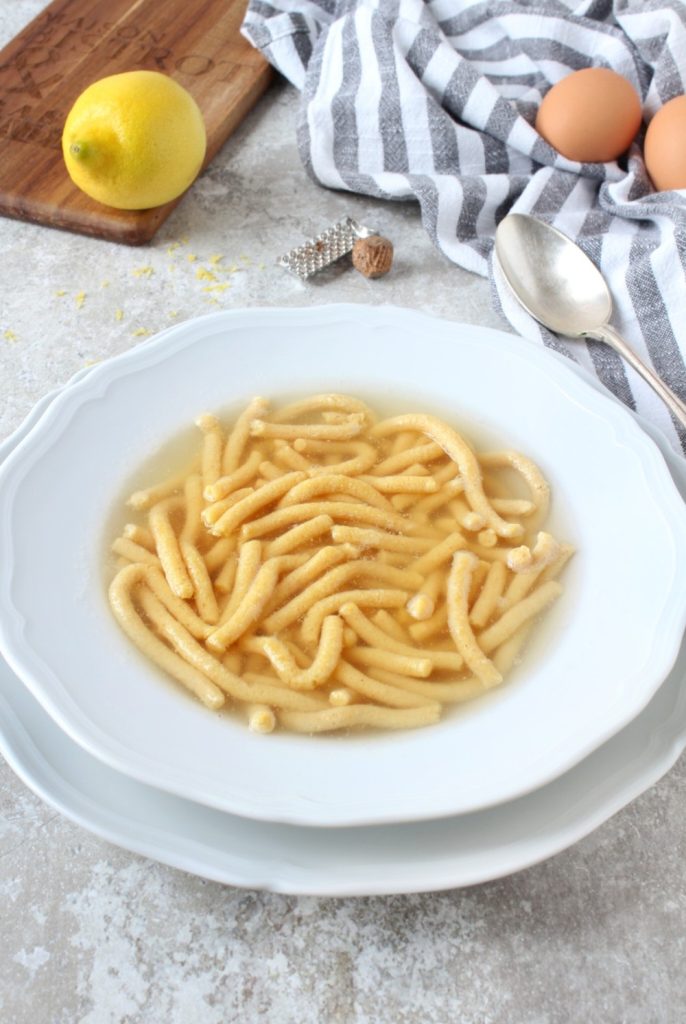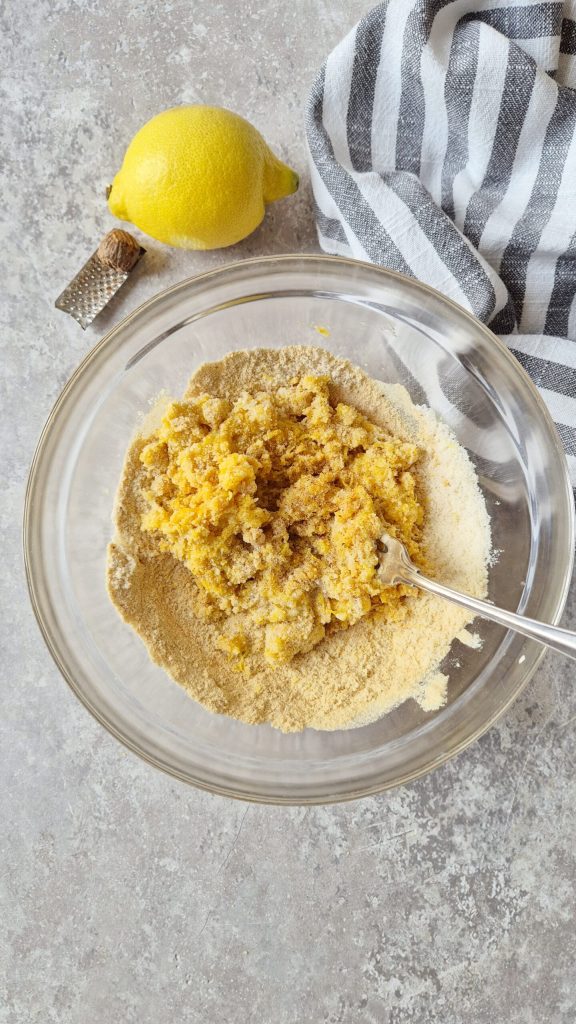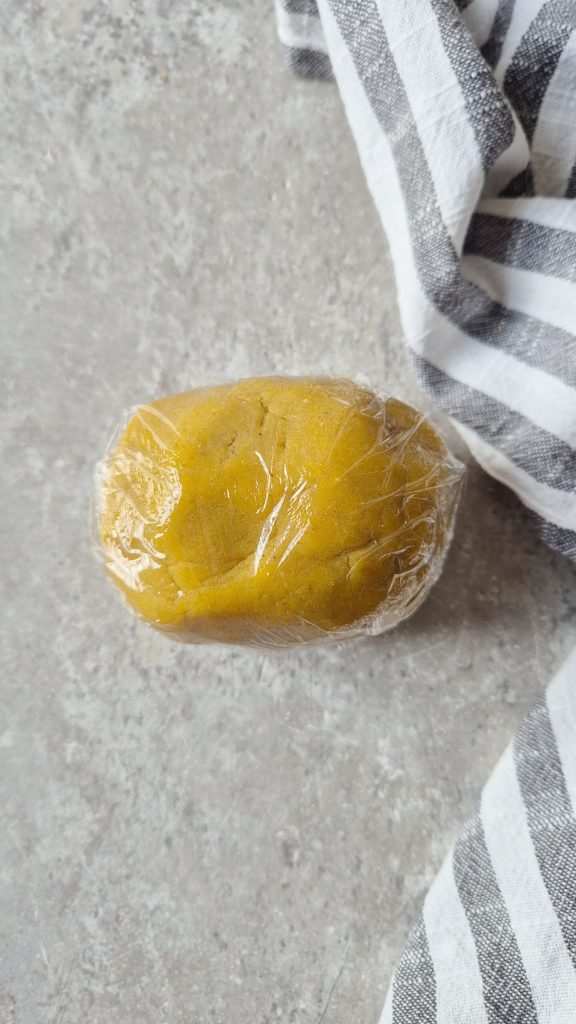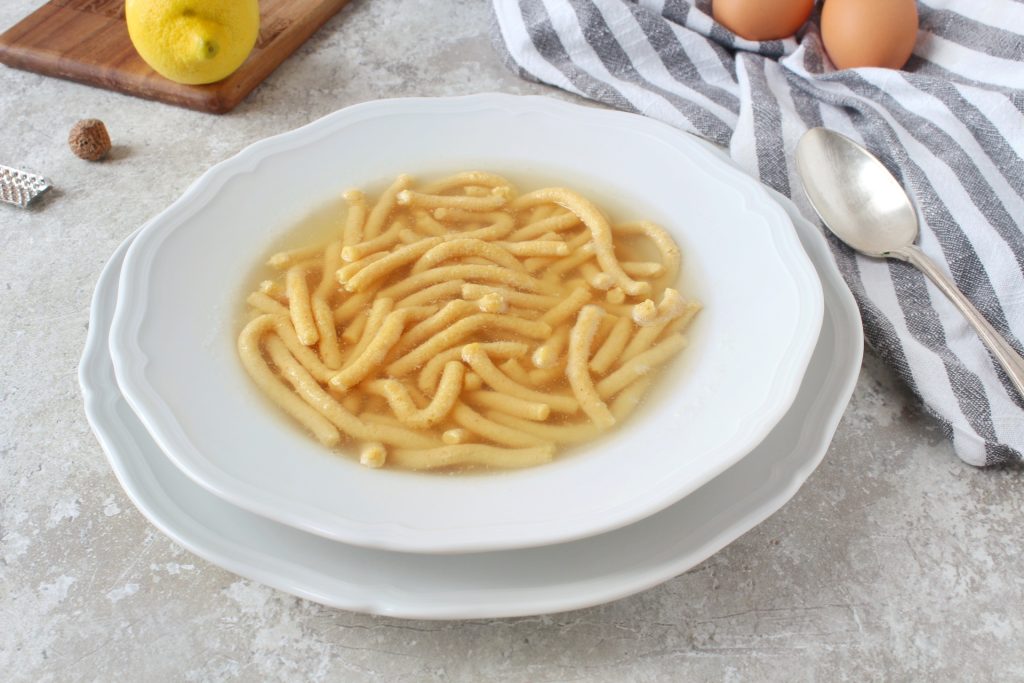The passatelli in broth are a typical recipe of the Romagna tradition, with origins even dating back to medieval times.
Passatelli, in fact, are characteristic of the so-called ‘poor cuisine’, as they are made with only three main ingredients: eggs, breadcrumbs, and grated parmesan.
The proportions among the three ingredients, ranging from Emilia-Romagna to Marche, are very similar from recipe to recipe; some prefer to use equal amounts of breadcrumbs and parmesan for each egg, others, like me, prefer to use a bit more breadcrumbs than grated parmesan.
Beyond these small differences, passatelli in broth are a very tasty and flavorful easy first course, to bring to the table during the Christmas holidays, on family Sundays, or even ideal to warm up your cold winter days as a personal treat.
Despite the obvious simplicity and speed with which passatelli are made, to prepare them best and avoid having them, alas, crumble as soon as you toss them into the boiling broth, a couple of simple but fundamental precautions are needed during preparation. I explain them in detail below in the procedure description.
Before moving on to the detailed recipe with step-by-step photos, I suggest three other of my recipes that you might also be interested in:

- Difficulty: Very Easy
- Cost: Very Cheap
- Rest time: 2 Hours
- Preparation time: 10 Minutes
- Portions: 4
- Cooking methods: Stovetop
- Cuisine: Italian
- Seasonality: Autumn, Winter and Spring
Ingredients to Make PASSATELLI IN BROTH
- 3 eggs
- 3 oz oz grated parmesan cheese
- 1 cup cup fine breadcrumbs
- to taste nutmeg
- to taste grated zest of half an untreated lemon (untreated)
- to taste salt
- to taste pepper
- 2 quarts meat broth
Tools
- Potato Masher for passatelli
- Pot large
- Sieve
Steps to Make PASSATELLI IN BROTH
In a bowl, pour the eggs and beat them for a few seconds with a fork, just enough to mix the yolks and whites together.

Add the breadcrumbs*, the grated parmesan, the lemon zest, the nutmeg, the salt, and the pepper, and start mixing the ingredients well with the fork.
* : the breadcrumbs to use must be EXTREMELY FINE, like a flour. At the end of the recipe, in the ‘Tips and storage’ paragraph, you will find more details on this.
When the dough becomes more compact, take it out of the bowl and start working it with your hands for about fifteen minutes; this step is very important, because this way the dough will become more elastic and will allow you to be more certain that your passatelli will not crumble once you dip them in the hot broth.

The dough, after working it, will have a smooth and compact appearance as you can see in the photo.

Wrap it in plastic wrap and let it rest in the refrigerator for a minimum of two hours and a maximum of twelve hours.

After at least two hours, it’s time to cook your passatelli directly in the meat broth. Take the dough out of the refrigerator and heat the broth until it boils.
Once it reaches a boil, insert the dough into the wide-hole masher, press forcefully positioning yourself directly over the pot with the broth.
Cut them by passing a smooth-bladed knife directly in contact with the masher; I recommend cutting them once they reach a good length, at least 4 inches, because in contact with the broth your passatelli might tend to break on their own.

Cook the passatelli for 2-3 minutes, then serve them still hot in a bowl with plenty of broth 🙂

Tips and Storage
Once you have created the dough for your passatelli, you can store it for a maximum of 24 hours in the refrigerator.
Instead of tossing the passatelli directly into the broth, you can choose to shape them on a board and, once you have finished forming them all, cook them a little at a time, especially if you have prepared a large quantity.
IMPORTANT TIPS:
Although the process of making passatelli is extremely simple, many people get discouraged after the first attempts, because it’s not uncommon for passatelli to crumble once you drop them into the broth (literally).
The most important advice I can give you to avoid this unpleasant inconvenience (because it’s happened to me too!) is to use EXTREMELY FINE breadcrumbs, it should look like flour! To do this you have two options:
– make it directly at home, using common dry bread, grinding it in a mixer until it reaches a super fine grain, and, besides this, sieve it, or
– buy it already made, but still pass it in the mixer until obtaining a grain similar to flour and sieve it as well.
Another very important tip to make your dough more elastic and therefore minimize the chances of passatelli crumbling during cooking, is to work it with your hands energetically for at least 10-15 minutes. The more elastic the dough is, the better it will hold all the ingredients together; and elasticity is achieved precisely by working it as much as possible.
Among the ingredients to make passatelli, flour is absolutely not foreseen, but if you are very discouraged by unsuccessful attempts with other recipes, you can add a pinch (but just a pinch, maximum a teaspoon) just to regain confidence and try again without flour and especially with all my tips the next times 😉
Among the ingredients to make passatelli, flour is absolutely not foreseen, but if you are very discouraged by unsuccessful attempts with other recipes, you can add a pinch (but just a pinch, maximum a teaspoon) just to regain confidence and try again without flour and especially with all my tips the next times 😉
FAQ
What type of breadcrumbs should be used to make passatelli?
For passatelli, the breadcrumbs to be used must be very fine, like flour, and come from common bread; therefore avoid milk bread, oil bread, or other very seasoned bread.
How to prevent passatelli from crumbling once tossed into the broth?
To avoid as much as possible the risk of passatelli crumbling once in contact with the boiling broth, it is very important to use very fine breadcrumbs and work the dough with your hands for at least 10-15 minutes to make it sufficiently elastic.
Is flour included in the traditional passatelli recipe?
No, flour is not included in the traditional recipe, and it is absolutely not necessary for the successful outcome of the recipe, indeed. However, especially for those who need to make large quantities, it is often used to ensure that the passatelli do not crumble during cooking. Before resorting to this ‘trick’, however, I strongly recommend reading all the tips I have written in the recipe description, they are really very important.
If you want to prepare dry passatelli, is the recipe the same?
Yes, the recipe does not change, indeed, the passatelli will still need to be cooked in boiling broth and once drained, seasoned to taste.

